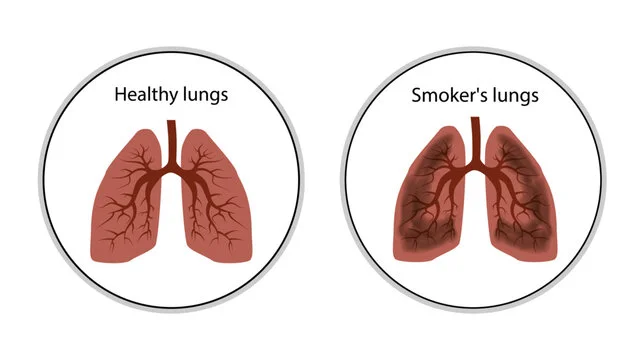What Are the Smoking Impacts on the Body!
“You breathe over 20,000 times a day — but have you ever wondered what’s really in the air you’re inhaling? What if we told you that city life might be silently damaging your body more than you think? and you clearly know smoking impacts in cigarette”
New research suggests that people who have small airways for their lung size may have problems breathing, increasing their risk for chronic obstructive pulmonary disease (COPD)—even if they don’t smoke or face any other risk factors. The study, which was funded in part by the National Institutes of Health’s National Heart, Lung, and Blood Institute (NHLBI), is published June 9 in the journal JAMA.
COPD is a disease that gradually damages the lungs and causes breathing difficulties. It’s usually smoking impacts, but researchers have been surprised to find that about a third of COPD cases occur in people who have never smoked. Now, this study may suggest that one reason for the condition may be the way some individuals’ lungs develop.
“In-depth analysis of lung images from COPD patients suggests that abnormal lung development may be a contributing factor to the increased risk of COPD in older adults,” said Dr. James Kiley, director of NHLBI’s Division of Lung Disease. “Understanding what may be driving this phenomenon and how it can be addressed requires further research,” he added.
You May Also Like: GlucoTonic Reviews – Is This Blood Sugar Supplement Worth It?
COPD is the fourth leading cause of death in the U.S. It causes respiratory obstruction and breathing problems that can severely impact day-to-day activities. Although factors such as smoking impacts, pollution and asthma are considered to be the major causes of the disease, 30% of cases of COPD occur in people who have never smoked. Some heavy smokers also remain disease-free, suggesting that other risk factors may also be responsible for the disease.
Previous studies have indicated that many adults with COPD have had some lung damage early in life. Dr. Benjamin Smith, a pulmonary specialist at Columbia University in New York, who was involved in the new study, elaborated on this.
These CT scans of the airways (in red) and lungs (in black) show different forms of dyspnea. They show small airways compared to the size of the lungs (left) and normal-sized airways (middle), as well as large airways compared to normal-sized airways (right). These scans clearly show changes in the size of the airways and their relationship to the size of the lungs, which can be helpful in diagnosing respiratory diseases such as COPD.

Air enters the lungs through airways, which start from the trachea and divide into smaller bronchioles. As a person ages, the size of these airways increases in proportion to the size of their lungs. However, in some individuals the airways may be smaller or larger than expected, and this is called dyspnea, although the reason for this is not yet clear.
To find out whether smaller airways could be responsible for COPD, Smith and his team studied data from more than 6,500 older adults who took part in three major studies. These studies included both groups of people with COPD and never smokers. All of the studies used computed tomography (CT) scans of the lungs.
The results of these studies showed that people who had small airways relative to lung size were more likely to develop COPD than those who had large airways. This relationship was also observed after taking into account standard risk factors such as smoking impacts, pollution and asthma, and the problem was more common in individuals with smaller airways.
“Our results prove that small airways in proportion to lung size are a major risk factor for COPD. This helps us understand why 30% of COPD cases occur in people who have never smoked,” said lead author of the study Dr Smith. He also said that lung function declines with age, so individuals who already have small airways may be at increased risk for COPD, even if they are never smokers.
Dr. Smith also said that these findings may help explain why some long-term smokers do not develop COPD. Individuals who have relatively large airways may be able to tolerate the lung damage caused by smoking and have enough respiratory capacity to survive it. However, given the other health problems caused by tobacco, he stressed that smokers should make every effort to quit.




